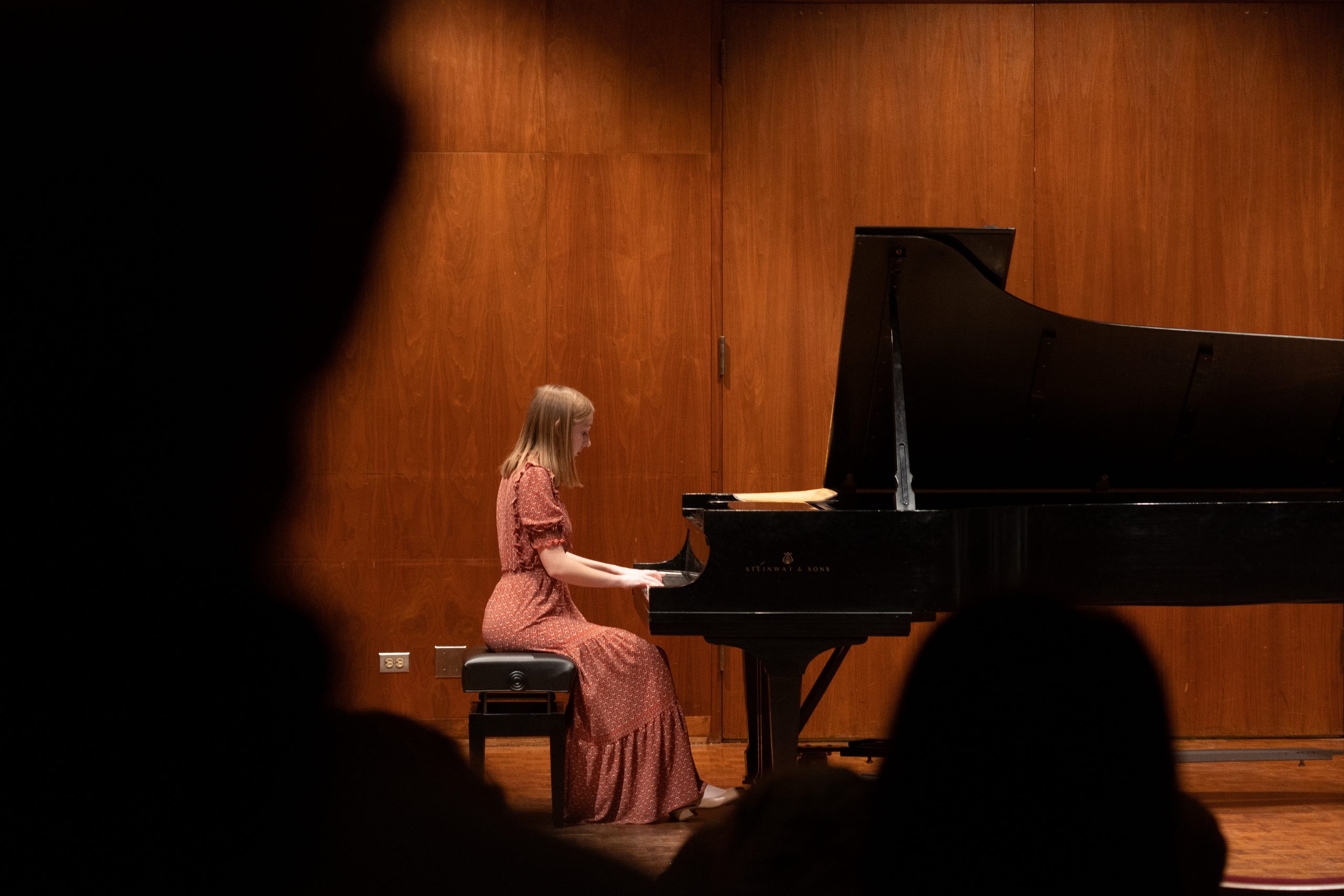What do Frédéric Chopin and Augusta Read Thomas have in common? Despite living on different continents, over a century apart, they were both inspired by a spirit of improvisation.
Junior Reese Pike’s piano recital in Harper Hall on Sunday, Feb. 19 combined classical and jazz works by these composers and others, including two original pieces by Pike, into a cohesive program that displayed her versatility as a musician while also showcasing unexpected similarities across musical genres.
The first piece on the program was Chopin’s Impromptu No. 3 in G-flat Major, Op. 51. This piece began with a graceful unaccompanied melody wafting in, before it was joined by an accompaniment that gave the piece the twirling feeling of a dance. This character returned at multiple points throughout, but the piece also meandered into sections that were fuller and more chordal, with a hymn-like feeling, as well as moments that felt more questioning. After a carefree, almost frivolous passage, the piece ended with a sense of confident certainty.
The next piece on the program was “Tango” by Augusta Read Thomas, the third movement of a larger work titled “Traces.” It included the subtitle “Like Astor Piazzolla crossed with John Coltrane,” and Pike explained that while there were no musical quotes from either composer in the piece, Thomas imagined it as “a captured improvisation of what could be.”
The piece opened with harsh and grumbly bass chords, followed by a more delicate section higher in the piano’s range. The contrasting characters within these different ranges continued to be juxtaposed throughout the piece, with rapid transitions between them or with both occurring simultaneously. In the upper range, the piece was more melodic and featured many trills and fluttery passages, although it did incorporate some of the starker chords that usually appeared in the lower range. The piece ended with trills and a final staccato in the upper range of the piano, with a playful sense of unfinishedness.
Next came two of Johannes Brahms’ Six Pieces for Piano, Op. 118. The first of these was “Intermezzo in A minor.” This piece had a lush, generous sense of harmonic fullness to it. While never hurried, it maintained a focused energy, only subsiding into a more restful state as it came to an end. Pike then performed the fifth piece in this set, “Romance in F Major.” For most of its duration, this piece was much more tender and reflective than the previous one, although there were also more active sections ornamented with plentiful trills.
Pike was then joined on stage by junior Lily Nittler for “I’ve Grown Accustomed to Her Face,” a piece from the musical “My Fair Lady,” with music by Frederick Loewe and lyrics by Alan Jay Lerner. In the musical, this song is sung by one character after another character whom he has gotten to know well, and perhaps even fallen in love with, expresses her anger with his mistreatment of her and leaves him behind. In singing the song, he expresses the difficulty he finds in moving on from her after the ways that her presence in his life has changed his routines. Pike mentioned that she grew up listening to a lot of musicals and found it fun to get to perform the piece in a different context.
After a slow and sentimental piano intro culminating in a flourish, Nittler began to sing the wistful melody. Occasional dissonance between singer and piano accompaniment further emphasized this melancholy yearning. In the middle of the piece, the piano had an extended solo, almost as though the singer were so absorbed in memories that she forgot to sing. Eventually, she reentered and continued in the same mood as earlier, before the piece came to an end with the piano playing the part of the melody that corresponded to the titular lyrics a final time.
The final two pieces of the program were both written by Pike and performed with first-year Vivian Shanley on bass and senior Ryan Gowdy on drums. First, they performed “Morning Walk” together. It began with a casual and optimistic piano intro, and then Shanley and Gowdy joined in, giving additional energy and excitement to the piece. Each of the instruments got their moment to shine, and there was also a sort of back-and-forth dialogue between piano and drums in one section. While the percussionist used drumsticks for the majority of the piece, they used brushes at the beginning and end, allowing the music to build up and fade out over the course of the piece.
To conclude the program, Pike, Shanley and Gowdy performed “Orange and Yellow” by Pike. After a quick pick-up in the drums, the other instruments joined in. The piano took the most prominent part in the overall sound, while still allowing space for the bass and percussion to be present, enhancing the rhythm and texture of the piece without overpowering the piano. The piece had a relaxed, easygoing quality throughout. After a call-and-response motif from piano to bass, the three instruments finished together.
By interspersing both jazz and classical pieces within her recital, Pike brought the genres into conversation with each other, revealing obvious differences and sometimes more subtle connections between them. In doing so, she showcased her musical versatility through both solo and collaborative performance, as well as her ability to both create her own compositions and interpret those written by others across a variety of styles.


